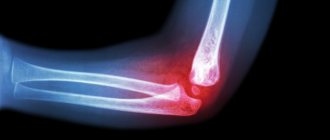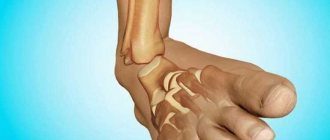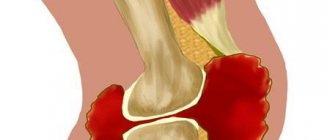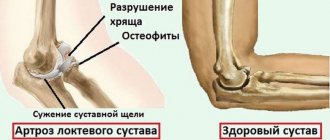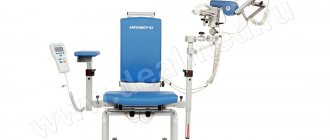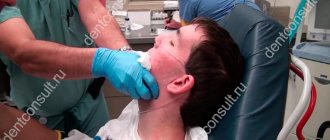Rehabilitation of the elbow joint
carries out various types of joint rehabilitation, including rehabilitation of the elbow joint.
We accept patients of any severity after discharge from the hospital and achieve complete restoration of the function of the elbow joint. Anatomically, the most complex joint in the human body is the elbow. It is composed of the radius, ulna and humerus, which gives the joint high mobility. The joint has a very complex structure. It contains several small joints that provide proper free movement. It's all held together by a system of tendons. The entire structure is permeated with nerves and blood vessels. Therefore, injuries to the elbow joint are usually very severe, they take a long time and are painful, and if proper rehabilitation is not carried out, the consequences remain for life.
Rehabilitation of the elbow joint is extremely difficult, even though it is easy to immobilize the injured area and examine the injured area. There are a number of techniques for restoring the elbow joint, and non-invasive treatment methods, such as exercise therapy and physical therapy, are rapidly developing.
Reconstruction of the elbow joint today, even despite the great technological progress in modern medicine, remains largely unchanged. Particularly difficult is the timely diagnosis and prevention of the inflammatory process, in which rehabilitation becomes significantly more complicated and the likelihood of new exacerbations appears. Against this background, the importance of physical therapy (physical therapy) as a universal and time-tested method is increasing.
Selection of a specific method of exercise therapy, exercises and determination of the duration of the entire rehabilitation process after injury to the elbow are only part of the tasks that fall on the rehabilitation physician. There are dozens of sets of exercises, so-called schemes, which can be replaced with one another as they are used. They are not universal; the effectiveness of certain sets of exercises is directly related to the patient’s age, the nature of the damage to the elbow joint, general health and other details. Considering the complexity of this science, it is categorically not recommended to carry out rehabilitation on your own, but to carry it out under the supervision of rehabilitation specialists.
With prolonged immobilization, muscle tissue and joints in the human body inevitably atrophy. The peculiarity of the structure of the elbow joint is such that immobilization has a particularly detrimental effect on it - it can result in decreased mobility for the rest of life. Irreversible consequences of injury are designed to prevent such measures as:
- Massage;
- Kinesitherapy – development of joints;
- Interference therapy – stimulation with currents; aimed at reducing tissue swelling;
- Phonophoresis is an ultrasonic effect that stimulates the regenerative function of tissues.
To restore the elbow joint, it is also possible to use passive methods, for example, tape. Recently, the use of tapes has increased; they are designed not only to relieve pain during exercise therapy, but also to prevent muscle spasms and, to some extent, relieve swelling.
We note once again that, due to their complex anatomical structure, injured elbow joints are especially in need of professional rehabilitation. And a huge role in this is played by the patient’s very desire to overcome the injury without consequences, his motivation and willingness to listen to the professional advice of doctors.
Why choose us
Gym and Wi-Fi
Guests and visitors can use free Wi-Fi. And for those who want to exercise, our boarding house has a gym.
Air conditioning and TV
We provide comfortable living conditions for all our guests. Try staying for at least a week and you will love it!
Medical equipment
We have all the necessary equipment to maintain your health, and our attentive staff will provide assistance if necessary.
Board games and books
A large selection of books and board games is freely available for our guests. The staff gives regular health lectures.
Elbow fractures
An elbow fracture is a very common injury. In addition, one of the most difficult to restore. The patient faces a period of immobilization, that is, immobilization of the arm, and then has to undergo long-term rehabilitation. Fractures of the ulna usually occur after a fall. Elderly women especially suffer from these injuries, whose bones become very fragile with age, and any push or stone in the way can lead to a fall. Similar fractures also often occur in people actively involved in sports.
1.General information
Each joint, that is, a movable articulation of two bone structures, has a certain “degree of freedom” - and only within these limits are natural rotational, flexion-extension and other movements possible for a person.
If the head of one of the bones goes beyond the boundaries of the anatomical bed allocated to it by nature and cannot return on its own, this situation is called a dislocation or subluxation. The difference between one and the other can often be established only during instrumental examination (for example, x-ray): a complete dislocation is accompanied by destruction of the ligamentous apparatus; with subluxation, the ligaments can be stretched, but not torn. Another criterion is the presence or absence of contact of the articular surfaces: with subluxation they touch at least partially, with complete dislocation there is no contact.
Symptomatically, dislocation and subluxation are very similar - the joint turns red and swells, the limb is in an unnatural position, its mobility is sharply limited (with concomitant nerve damage, tactile sensitivity may also be impaired), the victim usually experiences severe pain.
It seems quite logical, from a mechanical and anatomical point of view, a trend long known to traumatologists: the more complex the joint, the more complex, diverse and dangerous its dislocations.
Shoulder dislocations lead in trauma statistics. Dislocations and subluxations of the forearm are in second place in terms of frequency of occurrence (20-25% of all recorded traumatic dislocations). According to some data, the gender and age structure of victims is dominated by males aged 10-30 years and females over 50 years old.
A dislocation (subluxation) of the forearm that has not been reduced in a closed manner for two weeks or more is considered old.
A must read! Help with treatment and hospitalization!
Why does a joint need to be developed after an injury?
After a fracture, the elbow joint must be cast; on average, the period of immobilization takes at least 3 months. This period is enough for the elbow joints to begin to atrophy - the tone of the muscles and tendons decreases, and their size decreases. After this, the hand is unable to perform even simple movements, and pain is felt.
To restore the flexion functions of the limbs, they resort to complex measures, which include various exercises, physiotherapy and medications. Rehabilitation of an elbow fracture involves physical therapy with the use of medications that stimulate blood flow. Such procedures are mandatory for a fracture of the elbow joint. Rehabilitation also includes joint exercises on special simulators, the use of restorative drugs, vitamins, and an oxygen cocktail.
Reviews from our clients
The situation is trivial - while playing tennis, I dislocated my right arm.
Very severe pain, swelling did not subside even after it was adjusted. They helped me in Baltiysky - the pain went away in a couple of days, mobility was restored within a week. True, she wore a special bandage for some time. I am grateful to the doctors for their help and warm attitude. Sofia K.
I went to a rehabilitation center with a diagnosis of dislocation and ligament rupture. At first, massage and exercise therapy were actively used. A month later I hardly remembered the injury, and now I recommend Baltiysky to all my friends - a modern, excellent center!
Ivan D.
Preventive recommendations
To prevent a painful injury that requires wearing a plaster cast, experts advise:
- use elbow pads during sports training;
- before physical activity, perform warm-up exercises;
- wear winter shoes with rubberized soles;
- avoid conflicts and fights;
- follow traffic rules.
If injury cannot be avoided, during treatment it is necessary to ensure complete rest for the injured arm , do not make sudden movements, and do not lift heavy objects. The elbow should be developed all the time - go to physical therapy, perform therapeutic exercises at home or under the guidance of a doctor. You also need to enrich your diet with vegetables, lactic acid drinks, meat, fish, and seafood.
You cannot remove the fixing bandage without permission, otherwise serious complications may arise that will prevent the arm from returning to normal motor ability.
When to start developing a joint?
The period when rehabilitation of the joint begins begins almost immediately after the removal of the plaster. The main thing here is to act without haste, since after an elbow fracture, excessive activity can only damage weakened muscles. As a rule, rehabilitation after an elbow fracture in the form of physical therapy, physiotherapy and water exercises takes from three to eight weeks - the duration depends on the nature of the joint injury. Properly carried out, the course allows you to restore the working function of the elbow joint by 100 percent.
3. Symptoms and diagnosis
The clinical picture of chronic forearm dislocation is very diverse; it is determined, first of all, by the direction of the displacement. Up to 90% of such cases are posterior dislocations - with this option, the forearm appears unnaturally short, and the shoulder, on the contrary, appears disproportionately long. The opposite picture occurs when the forearm is dislocated anteriorly; in this case, severe tendon damage and muscle ruptures often occur. Displacements outward or inward, as well as divergent dislocation (divergence of the radius and ulna in any plane) are very rare and, as a rule, have the character of a combined fracture-dislocation.
The intensity of pain, limitation of mobility, severity of swelling and hematoma depend on the degree of displacement of the articular surfaces and damage to the ligamentous apparatus; in the most severe cases, ligaments and muscles are torn off, and conductive nerves and blood vessels are also damaged.
From a diagnostic point of view, dislocations and subluxations of the forearm are usually not particularly difficult. However, to clarify the situation, an X-ray examination is required, both before reduction (which often makes it possible to diagnose fractures, cracks or other complications), and after - to monitor the anatomical correctness of the joint.
One of the most informative techniques is an X-ray contrast study with the introduction of a contrast agent into the joint space.
About our clinic Chistye Prudy metro station Medintercom page!
Stages of joint rehabilitation
Experts practice dividing the entire recovery period of the elbow joint after a fracture into three stages:
- First - start on the second or third day after removal of the plaster; consists of breathing exercises and careful movements of the joints of the limb recovering from a fracture - bends, periodic muscle tension. In the first period of rehabilitation, the patient undergoes a series of diagnostic procedures that give the attending physician the opportunity to correctly draw up a rehabilitation plan. The doctor may prescribe an arteriogram, x-ray, or consultation with a neurologist, since its treatment depends on the type of fracture. Each patient's pulse, body temperature and blood pressure must be monitored.
- The second is recovery after fractures of the elbow joint due to more thorough loads. Exercises such as “shoulder rolling”, exercises with a ball, stretching of joints are practiced; an important part of the second stage is daily warming baths.
- The third is physical therapy, including compresses, heating, and electrical stimulation. They resort to it if the joints could not recover 100 percent after the first two stages.
In order to quickly heal a fracture, physical activity should be regular, ideally done twice a day, with 5 approaches per exercise. Breaks are permissible only in cases of increased fatigue and severe pain. Rehabilitation of the elbow joint after a fracture is not a quick process and requires a lot of patience not only from patients, but also from doctors. But if all medical prescriptions are followed, it is usually crowned with success.
Treatment of dislocations
Diagnosis of damage is carried out by a traumatologist or rheumatologist using radiography, ultrasound, and computed tomography. If the child has no other injuries, the dislocation is reduced under general anesthesia: the joint is stretched, its head is directed into the articular cavity. A splint is applied to the injured arm; the immobilization period is 10–15 days. After removal of the fixing bandage, rehabilitation therapy begins for 3–4 weeks.
Complex dislocations accompanied by fractures require plaster immobilization of the injured limb. The child may require treatment from a neurologist (for nerve damage) or a surgeon (surgical intervention for ruptured tendons, arteries, blood vessels, muscles).
Our clinic provides a full range of diagnostic and treatment procedures for dislocations in children. The clinic is equipped with all the necessary equipment, and its own hospital allows patients to be placed in comfortable rooms for the period of therapy.
How is rehabilitation of the elbow joint different after a dislocation?
Very often, people who have suffered a dislocation of the elbow joint underestimate the danger of this injury. And this is a big mistake. Rehabilitation of a dislocation is no less complex a process than recovery from a fracture, and it can only be entrusted to very qualified and experienced doctors in a reputable medical facility. center.
The complexity of such an injury is that the complaints of patients are completely different. This means that recovery must be different for each patient.
Treatment for a dislocated elbow joint consists of restoring motor functions. The doctor usually prescribes exercise therapy to develop the elbow and other procedures that activate the joint.
Prevention of dislocations
Prevention of dislocations is based on the formation of a balanced menu for the child’s nutrition. A sufficient amount of minerals and vitamins in food will provide the baby’s joints and bones with sufficient strength to painlessly endure falls that are inevitable during childhood activities.
Parents should also take care of the physical development of their growing sons and daughters. Swimming, running, and playing with a ball help improve children's coordination and strengthen skeletal bones and muscle tissue. Moms and dads should remember that babies’ bodies cannot bear the same stress as adults.
Stages and measures after elbow dislocation
The initial stage of treatment is followed by a period of long recovery. Even if the dislocation is successfully reduced, the risk of complications remains. It is very important to ensure proper fusion of cartilage, connection of nerves and blood vessels in the damaged area. A successful recovery is largely the responsibility of the victim himself, and not just the result of the doctor’s work.
Rehabilitation of the elbow joint after a dislocation involves the following measures:
- Exercise therapy or physical therapy, a set of exercises aimed at developing the joint;
- Physiotherapy – comprehensive measures to accelerate cartilage regeneration and relieve pain;
- Massage;
- Drug treatment;
- Healthy and balanced diet;
- A course of taking vitamins – both external and internal use.
The purpose of physiotherapy and massage lies in restoring full blood circulation - this speeds up the healing process as much as possible. Massage procedures can begin no earlier than five weeks after the elbow injury, and the goal of the event is to prevent inflammation of the tissues surrounding the dislocation.
If healing is accompanied by swelling and pain, the victim is prescribed physiotherapy. As with massage, such therapy is indispensable in restoring joint function and speeds up the complete healing of the limb.
Special medications are introduced directly into the tissue of the dislocated area in the elbow - an antiseptic enters the body with ointments. It’s the same with vitamins, but in addition to external use, they can also be taken orally. Their importance should not be underestimated, since without vitamins, restoration and rehabilitation of the joint will inevitably be delayed, and the regenerative functions of tissues will slow down.
A possible addition to ointments is compresses. With them, rehabilitation proceeds in generally the same way, but an additional effect is created due to warming up the joint and surrounding healthy tissue areas. In addition, compresses can ensure the delivery of necessary minerals to damaged cartilage.
Types and classification
An elbow dislocation can be fresh (2-3 days from the moment of injury), stale (up to 14 days), old (more than 2 weeks). Based on the signs and nature of damage, the following types are distinguished:
- Simple. When displaced, the joint capsule ruptures, but bone, nerve, and blood tissues are not damaged.
- Difficult. The displacement is complicated by a violation of the integrity of the ulnar nerve, brachial artery, and bones.
In the direction of dislocation there is:
- Rear It happens when a person falls on his outstretched arm. Often combined with trauma to the coronoid process.
- In front of him. Occurs when there is a blow to the arm bent at the elbow. Rarely seen.
- Lateral. Occurs due to mechanical impact on the lateral surface of the joint. Often accompanied by displacement of the bones of the forearm inward or outward, and injury to the nerve roots.
If the dislocation occurs repeatedly, it is called habitual dislocation . Damage occurs due to the anatomical features of the structure of articular structures of congenital or post-traumatic origin.
Rehabilitation of the elbow joint after surgery
Rehabilitation of the elbow joint after surgery is also carried out in our center. Surgery on the elbow joint for a fracture is often prescribed, and sometimes even results in several operations in a row. The operation can also be performed for dislocation, if the tendons are torn.
Our specialists have extensive experience in restoring the functions of the elbow joint after such operations. The list and number of procedures depends on the complexity of the operation, age and condition of the patient. The main thing is to contact us in time and believe in recovery.
Rehabilitation after surgery on the elbow joint is caused by a certain difficulty in restoring shape, which is associated with the high complexity of the anatomical structure of the body part, as well as possible reactivity.
Make an appointment
You can make an appointment with the children's specialists of JSC "Medicine" (clinic of Academician Roitberg) through the website. The interactive form allows you to select the general specialization of the doctor or the name and surname of a specific employee of the pediatric department.
The clinic covers all areas that can help in the treatment of dislocations: traumatology, surgery, neurology, pediatrics and others. Clinic administrators are ready to accept requests for appointments by telephone; calls are processed around the clock.
Features of rehabilitation of the elbow joint in the postoperative period
There is a possible increased reactivity directly to external stimulation, which may be caused by its innervation. When rehabilitation is carried out after surgery, the location of the fracture itself, its nature, the severity of reactive changes, the age factor and much more are initially determined. In the elbow joint, you should strive for more intense physical exercises, since procrastination largely determines secondary changes, and difficulty with joint mobility is noted.
Actually, movements in the elbow joint can begin after receiving an affirmative answer from the operating surgeon, which is caused by a number of complications in the arm area. The very first exercises should be aimed directly at restoring the elasticity of muscle tissue located near the shoulder, wrist, and joint elements in the hand area. The exercise is carried out with light tension and muscle relaxation, which is performed either with outside help or independently. As a rule, this is a period two weeks after the operation has been performed, strictly then the restoration of the elbow joint is carried out.
Consequences of injury, possible complications
Unpleasant consequences after a dislocation can develop even with proper treatment and timely realignment of the bones. As a result, a person cannot fully move his arm or perform usual actions. The most common complications are:
- contracture – deformation of tissues with loss of range of motion by the joint, due to which the arm cannot bend or straighten;
- scarring of tendons and ligaments caused by weakening of muscle fibers, which leads to decreased performance and an increased risk of re-dislocation;
- destruction of the cartilaginous layer covering the heads of the bones that form the elbow joint, which is fraught with the development of osteoarthritis.
Patients also experience damage to ligamentous muscle tissue, which can lead to the development of cubital syndrome . Due to constant compression of nerve endings, the risk of developing neuropathy increases significantly.
Prices for rehabilitation services
Cost of stay from 1500 rub. day.
| Services list | Cost of services |
| Initial consultation with a therapist for residents | For free |
| Consultation with a specialist doctor | 1500 |
| Speech therapist | 1500 |
| Psychologist | 1500 |
| Manual therapy | 1500 |
| Electrocardiogram with interpretation | 900 |
| Ultrasound examination (ultrasound) | 1000 |
| Physiotherapeutic procedures | 700 |
| Physiotherapy | 750 |
| General massage (back, neck) | 1000 |
| Foot massage | 600 |
| Hand massage | 400 |
| IV | 700 |
| IV administration of drugs | 300 |
| IM administration of drugs | 250 |
| Setting up a cleansing enema | 300 |
| Laboratory diagnostics | According to the price list |
